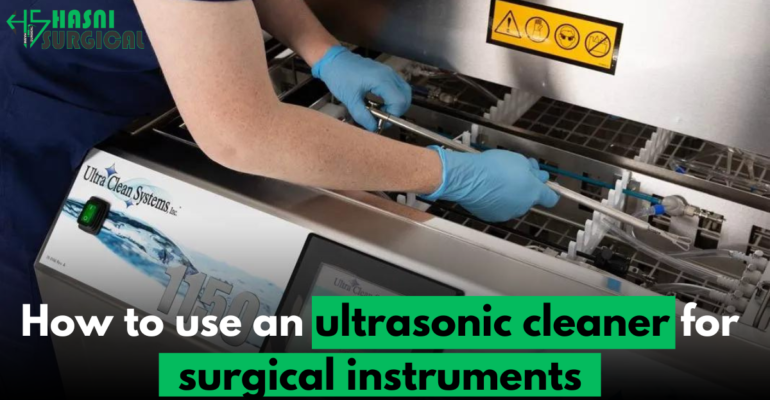how to use an ultrasonic cleaner for surgical instruments
July 6, 2024 2024-08-24 7:11how to use an ultrasonic cleaner for surgical instruments

how to use an ultrasonic cleaner for surgical instruments
Cleaning surgical instruments thoroughly is crucial to ensuring they are free from contaminants and ready for sterilization. An ultrasonic cleaner is an effective tool for achieving this. Let’s explore how to use an ultrasonic cleaner for surgical instruments in a detailed and practical manner.
about altrasonalic cleaners
Ultrasonic cleaners use high-frequency sound waves to create tiny bubbles in a cleaning solution. These bubbles implode, producing a gentle scrubbing action that removes contaminants from the surfaces and crevices of surgical instruments. This method is highly effective because it can clean areas that are difficult to reach with manual cleaning.
Ensuring surgical instruments are thoroughly cleaned is paramount to their safe use in medical procedures. An ultrasonic cleaner proves indispensable in achieving this cleanliness, utilizing high-frequency sound waves to create microscopic bubbles in a cleaning solution. These bubbles implode upon contact, effectively scrubbing away contaminants from the surfaces and intricate crevices of surgical instruments without causing damage.
To utilize an ultrasonic cleaner effectively, begin by preparing the cleaning solution designed specifically for surgical instruments. Once the cleaner is filled and the solution degassed, manually pre-clean the instruments to remove visible debris. Carefully arrange the instruments in the cleaner’s basket, ensuring they do not overlap to allow the cleaning solution and ultrasonic waves to reach all areas evenly.
Set the ultrasonic cleaner to the appropriate cycle duration—typically between 5 to 10 minutes—depending on the level of contamination. Close the lid to contain the cleaning action and prevent splashing. After the cycle completes, rinse the instruments thoroughly with distilled water to remove any residual solution.
Inspect the instruments for cleanliness, repeating the process if necessary. Finally, ensure the instruments are dried completely with a lint-free cloth or air-dried before proceeding to sterilization. Following these steps diligently ensures surgical instruments are impeccably cleaned, minimizing the risk of infection and maintaining high standards of hygiene in medical settings.

Ultrasonic cleaners offer several key benefits for cleaning surgical instruments:
Effective Cleaning: Ultrasonic cleaners use high-frequency sound waves to create microscopic bubbles in a cleaning solution. These bubbles implode on contact, effectively scrubbing contaminants from the surfaces and crevices of surgical instruments. This method ensures thorough cleaning, even in hard-to-reach areas.
Gentle on Instruments: Unlike manual scrubbing or harsh cleaning methods, ultrasonic cleaning is gentle on delicate surgical instruments. It reduces the risk of damage that may occur with abrasive cleaning techniques, extending the life of the instruments.
Time Efficiency: Ultrasonic cleaners can clean multiple instruments simultaneously, saving time compared to manual cleaning. This efficiency is crucial in busy medical environments where instruments need to be cleaned quickly for reuse.
Consistency: The cleaning process in an ultrasonic cleaner is consistent and reproducible. It ensures uniform cleaning across all instruments, regardless of their shape or complexity, reducing the chance of missed spots or inadequate cleaning.
Removal of Biofilms: Biofilms, which can harbor bacteria and other pathogens, are effectively removed by ultrasonic cleaners. This thorough cleaning helps prevent cross-contamination and reduces the risk of surgical site infections.
User-Friendly: Operating an ultrasonic cleaner is relatively straightforward. Once set up and loaded with instruments, the cleaning cycle can be initiated with minimal supervision, allowing healthcare professionals to focus on other tasks.
Compliance with Standards: Using ultrasonic cleaners helps healthcare facilities comply with strict hygiene and sterilization standards. It ensures that surgical instruments meet required cleanliness levels before undergoing sterilization procedures.

Ultrasonic cleaning vs manual cleaning
| Aspects | Ultrasonic Cleaning | Manual Cleaning |
|---|---|---|
| Effectiveness | Highly effective in removing contaminants from surfaces and crevices using sound waves and bubbles. | Effective but may not reach all intricate areas; relies on manual scrubbing. |
| Gentleness | Gentle on delicate instruments, reducing the risk of damage over time. | Can be abrasive, potentially causing wear on instruments with frequent use. |
| Time Efficiency | Cleans multiple instruments simultaneously, saving time and labor. | Time-consuming, requires individual attention to each instrument. |
| Consistency | Provides consistent and reproducible cleaning results across all instruments. | Cleaning quality may vary based on individual technique and attention. |
| Automation | Minimal supervision needed once set up; allows multitasking for healthcare staff. | Requires constant oversight and manual effort throughout the cleaning process. |
| Control and Inspection | Limited direct control during the automated cleaning process; inspection is post-cleaning | Offers direct control and visual inspection during the cleaning process. |
| Accessibility | Requires specialized equipment and setup, not universally available in all settings. | Can be performed with basic equipment and manual labor, accessible in various healthcare settings. |
| Cost | Higher initial investment for equipment purchase and maintenance. | Lower initial costs; ongoing labor costs may be higher depending on staffing. |
| Flexibility | Effective for complex instruments with intricate designs and hard-to-reach areas. | Allows customized cleaning approaches tailored to specific instrument types and contamination levels. |

Why use an ultrasonic cleaner?
Using an ultrasonic cleaner offers several benefits:
- Efficiency: It can clean multiple instruments simultaneously, saving time.
- Thoroughness: It reaches into small crevices and difficult-to-clean areas.
- Gentleness: It cleans without damaging delicate instruments.
Step-by-Step Guide to Using an Ultrasonic Cleaner
1. Preparing the Ultrasonic Cleaner
- Fill the Tank: Start by filling the ultrasonic cleaner’s tank with a suitable cleaning solution. It’s important to use a solution specifically designed for ultrasonic cleaning of surgical instruments to ensure effective cleaning and prevent damage.
- Degas the Solution: Turn on the ultrasonic cleaner and let it run for a few minutes to degas the solution. This process removes any air bubbles that might interfere with the cleaning process.
2. Pre-Cleaning the Instruments
- Manual Debris Removal: Before placing instruments in the ultrasonic cleaner, manually remove any visible debris. This can be done by rinsing the instruments under warm running water to remove blood and tissue residues.
- Soft Brushing: If necessary, use a soft brush to gently scrub the instruments. This step ensures that the ultrasonic cleaner can focus on removing finer contaminants rather than large debris.
3. Loading the Instruments
- Proper Arrangement: Carefully place the pre-cleaned surgical instruments in the ultrasonic cleaner’s basket. Ensure that instruments are not overlapping or touching each other too much. Proper arrangement allows the cleaning solution to reach all surfaces.
- Avoid Overloading: Do not overload the basket. Overloading can reduce the effectiveness of the cleaning process as the solution and ultrasonic waves need to circulate freely around each instrument.
4. Running the Cleaning Cycle
- Setting the Cycle: Set the ultrasonic cleaner to the appropriate cleaning cycle time. Typically, a cleaning cycle lasts between 5 to 10 minutes, but this can vary based on the level of contamination and the specific cleaner’s instructions.
- Cover and Run: Close the lid of the ultrasonic cleaner to prevent splashing and to contain the ultrasonic waves within the tank. Start the cleaning cycle and let the cleaner do its job.
5. Rinsing and Drying the Instruments
- Rinse Thoroughly: After the cleaning cycle is complete, carefully remove the basket from the ultrasonic cleaner. Rinse the instruments thoroughly with distilled water to remove any residual cleaning solution. This step is crucial to prevent any chemical residues from causing harm during surgical procedures.
- Inspect for Cleanliness: Inspect the instruments to ensure they are clean and free from debris. If necessary, run a second cleaning cycle for any instruments that still have contaminants.
- Dry Completely: Dry the instruments completely with a lint-free cloth or allow them to air dry. Ensure all moisture is removed to prevent corrosion and prepare them for sterilization.
6. Sterilizing the Instruments
- Sterilization Protocols: Once the instruments are clean and dry, they are ready for sterilization. Follow your facility’s protocols for sterilizing surgical instruments, which typically involve using an autoclave or other sterilization equipment. This final step ensures that the instruments are safe and ready for use in surgical procedures.

Tips for Effective Ultrasonic Cleaning
- Regular Maintenance: Regularly clean the ultrasonic cleaner’s tank and replace the cleaning solution as recommended by the manufacturer. This ensures the cleaner operates efficiently and effectively.
- Correct Solution: Always use a cleaning solution designed for ultrasonic cleaners and surgical instruments to avoid damaging the instruments.
- Avoid Overloading: Do not overload the ultrasonic cleaner, as this can reduce the effectiveness of the cleaning process. Proper spacing ensures thorough cleaning.
Conclusion
Using an ultrasonic cleaner for surgical instruments ensures they are thoroughly cleaned, reducing the risk of infection and contamination during surgical procedures. By following these steps and tips, you can maintain the highest standards of cleanliness and safety for your surgical instruments. Ultrasonic cleaners are a valuable tool in any medical facility, making the cleaning process efficient, thorough, and gentle on delicate instruments.




Comments (2)
clip downloader
Somebody essentially lend a hand to make significantly posts I might state That is the very first time I frequented your web page and up to now I surprised with the research you made to create this particular put up amazing Excellent job
hasni
thnaks